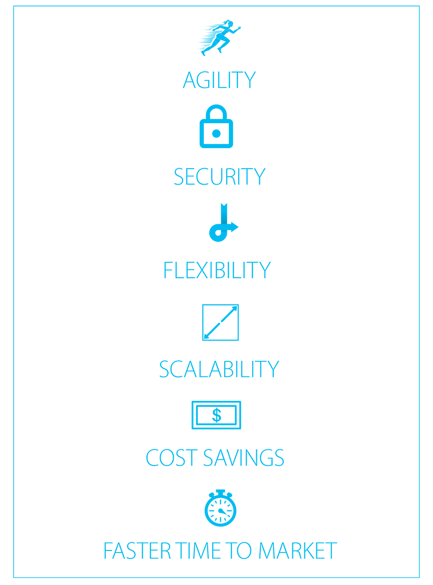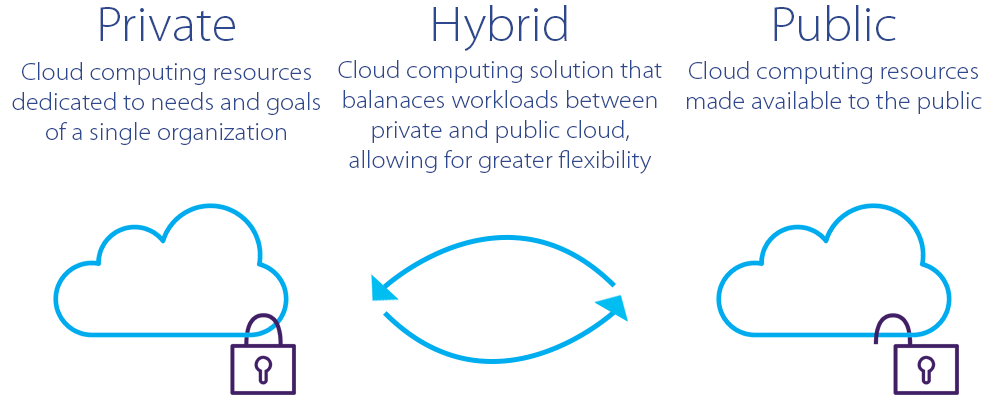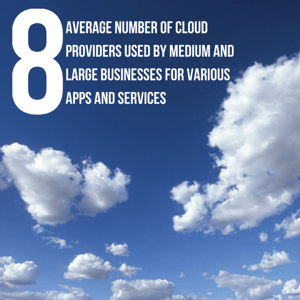Your cloud migration strategy gives you the ability to get your call control and applications delivered from a cloud server. It provides features and functionality on a subscription level basis that allows organizations to obtain advanced system benefits without a capital investment and long term asset depreciation.
Cloud computing brings a multitude of benefits to an organization. From simplified operations to cost-savings, there's reasons for everyone from your CFO to your IT Manager to celebrate modernized infrastructure. The modernization of infrastructure means the whole IT environment needs to be virtualized. This means compute, storage, networking and management for operations.

Benefits of a Cloud Migration:

Goals of a Cloud Migration
 Simplified Operations
Simplified Operations
Preserving on-premise solutions require constant maintenance for security, compliance and updates. Cloud solution providers often have dedicated staff that takes care of these things for you, alleviating your burden of responsibility.
 Increased Security
Increased Security
If you host all your data on-premise you run the risk of losing everything if a disaster, like flood or fire, strike. Offsite cloud backups are a great introduction to utilizing the cloud.
 Modernized Infrastructure
Modernized Infrastructure
Many companies that build and maintain their own infrastructure have out-of-date servers and components. By migrating to the cloud, not only do you modernize your infrastructure, but you save yourself the costs of building and maintaining your own infrastructure.
 Reliability
Reliability
Cloud environments are made of many servers that are controlled by a unifying piece of software that treats them as a single entity. All of these servers operating as one, safeguards against hardware failures.
 Availability
Availability
As your business grows, so too will the amount of data you store. By utilizing the cloud to store some or all of your data, you free up on-premise storage capacity. Stored in the cloud, your data is available to access by workers at home or in the office.
Types of Cloud Environments

Private (on-premise)
If you have the right expertise, you can craft the perfect cloud environment for your business.
- Full control of security, scalability, and configuration of servers
- Full responsibility for costs, security, and maintenance
Private (hosted) Cloud
Benefit from from hardware and resources exclusive to you without the need for security and maintenance know how.
- Hardware and resources all exclusive to you, no sharing
- Security is the responsibility of the solution provider
- Support teams assist with server management
- Cost savings on hardware, labor, and maintenance
Hybrid Cloud
A mix of both private on-premise cloud and third-party public cloud are utilized for increased flexibility and deployment options.
- Workloads can shift between private and public clouds depending on computing needs and costs
- No direct control over architecture of public cloud, private cloud architecture must be built to be compatible with the public cloud
Public: Infrastructure as a Service (IaaS)
IaaS is an easy and fast cloud solution. It is common to pay-per-use, making it cost effective to pay by the hour, week, month, or space occupied on virtual machines.
- IaaS providers host components that are normally on premise:
- servers, storage, networking, hardware, etc.
- IaaS providers deliver a multitude of services including:
- security, monitoring, log access, load balancing, data backup and resiliency, and detailed billing
Public: Platform as a Service (PaaS)
- Geared toward software development
- Hardware and software hosted on PaaS providers infrastructure
- Frees user from need to install in-house hardware and software
- Does not usually replace a business's entire infrastructure
- PaaS provides key services such as application hosting or Java development
Public: Software as a Service (SaaS)
SaaS is a highly scalable solution that allows you to easily access more or fewer services, on-demand, depending on your needs, goals, and budget.
- Reduced burden on in-house IT due to automatic updates and path management
- Access applications anywhere, anytime, from any internet enabled device
- Reliance on outside vendors to ensure things stay up and running while secure.
Cloud Provider Qualities to Look For
 Unification
Unification
Not all cloud-based solutions are created equal. Many aren't truly unified, but rather a collection of different platforms, each with their own hardware and software requirements plus unique management tools.
What to look for:
- Manage all communication and collaboration from one interface
- This will maximize the productivity of your IT department and minimize administrative costs
- A solution provisioned from Active Directory
- This will speed deployment and ease migration
- Templates for adding new users and applications
- This will make ongoing management much easier moving forward
 Flexible Deployment
Flexible Deployment
If your strategy is still evolving, you need a solution that can go to work right away in your existing hardware-based, on-premise IT environment and then deploy a cloud-based "everything as a service" strategy when you're ready to move on.
What to look for:
- Ability to change as your business evolves
- Work on-premise today, in the cloud tomorrow, and as a service next year.
 Easy Integration
Easy Integration
A cloud communications solution does not exist on its own, it needs to seamlessly integrate with existing infrastructure and business applications.
What to look for:
- A robust set of APIs
- This is needed to integrate with existing business applications like Microsoft Office and SalesForce
- It is ideal that your service provider is also part of the developer ecosystem that provides support for any custom integration work that may arise.
- Connections to people in different work roles
- Someone in the front office can easily interact with someone in the back office to quickly resolve an issue with a customer on the phone.
 Mobile Optimization
Mobile Optimization
With people working anywhere and everywhere, productivity is dependent on the ability to communicate and collaborate remotely and have a consistent experience regardless of location or device in use.
What to look for:
- A mobile client built from the ground up for mobile devices
- Many mobile clients merely mimic design and functionality of desktop apps, this often results in a glitchy and frustrating user experience
- Uniform experience across devices
- You want smooth switching between phones, tablets, corporate, and personal devices
- Automated provisioning
- This will quickly get employees up and running on the applications they depend on
 Innovation
Innovation
Cloud communications technology moves fast and evolves rapidly to meet the ever-changing needs of dynamic business environments. As the market grows at 10.5% annually, many upstart companies without experience are entering the market vying for their piece of the pie. For a good experience, look to the leaders in unified cloud communications.
What to look for:
- A reliable vendor with a history of delivering innovative new solutions
- Carrier-grade reliability
- Demonstrated experience in cloud-based subscription services
Developing Your Cloud Migration Strategy
With all the benefits of cloud communications, the solution is not a great fit for every organization. But having a defined cloud migration strategy can have a huge impact on your organizations transition to the cloud.
 Determine Feasibility
Determine Feasibility
Your goals will determine the exact requirements of your migration to the cloud. You need to determine if your proposed migration is feasible at a basic level. Ask yourself
- Do you have the necessary bandwidth available?
- Will your internet infrastructure reliably support the migration?
- Does your budget support the solution you need?
 Workload Strategy
Workload Strategy
Knowing exactly what type of environment you'll use and how you'll distribute the workload is essential for a successful migration strategy. You have many options to consider including:
- Private Cloud
- Hybrid Cloud
- Public Cloud
Most firms opt for hybrid cloud computing due to its wide range of benefits and high flexibility to deploy applications and services.
A clear outline of your workload strategy is crucial, so spend some time preparing this before you begin the migration.
 Schedule & Order
Schedule & Order
Downtime is inevitable when migrating to the cloud. If you're going to migrate multiple apps or platforms, you need to determine what order is the most efficient to mitigate downtime.
Consider:
- What exactly will you migrate?
- When will you migrate?
- How will each action affect your business and employees?
 Internal Communication
Internal Communication
Once you've determined your schedule, you'll need to find a way to clearly communicate that schedule to your stakeholders. Anyone affected by the migration should have the opportunity to respond with feedback long before migration begins, giving you time to address concerns and iron out any wrinkles.
 Procurement of Tools
Procurement of Tools
Will you have assistance in the cloud migration or are you completing the migration on your own? If you're doing the job solo, you'll want to make sure you have the right tools to get the job done and have the process run smoothly.
Asses the tools - software, web portal, etc. - designed to manage that process. When creating a cloud-based infrastructure, keep management tools in your focus and detail them as part of your cloud strategy.
 Detailed Documentation
Detailed Documentation
Not only will you need documentation of your strategy, but to ensure a successful migration you'll also need to document everything you know about your application and your data.
Create a plan for porting your applications, so that if you need to migrate them in the future or bring them back on-premise, you can.
Documenting your data structure is vital if you're moving to the cloud. You won't be able to manage your data without first creating both a clear data structure and documentation to support it.
Cloud Technology Trends

- Most firms plan to adopt the cloud model internally and externally
- Budgets for the cloud model are increasing
- Cloud storage reduces CAPEX and supplies top value
- Cloud helps curtail costs and boosts agility

